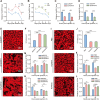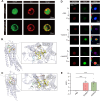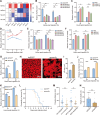Baculoviruses manipulate host lipid metabolism via adipokinetic hormone signaling to induce climbing behavior
- PMID: 39888969
- PMCID: PMC11819524
- DOI: 10.1371/journal.ppat.1012932
Baculoviruses manipulate host lipid metabolism via adipokinetic hormone signaling to induce climbing behavior
Abstract
Baculoviruses can induce climbing behavior in caterpillar hosts, which provides an excellent model for studying parasite manipulation of host behavior. Herein, we found that Helicoverpa armigera single nucleopolyhedrovirus (HearNPV) promoted lipid metabolism of infected H. armigera larvae, and changes in lipid metabolism can affect climbing behavior. Therefore, understanding the molecular mechanisms between lipid metabolism and climbing behavior is particularly important. In this study, we found adipokinetic hormone 1 (HaAKH1), adipokinetic hormone 2 (HaAKH2) and their receptor HaAKHR were essential for promoting lipid metabolism and climbing behavior in response to HearNPV infection. Both molecular docking result and Ca2+ imaging showed that both HaAKH1 and HaAKH2 could interact with HaAKHR. Knockdown of HaAKH1, HaAKH2 and HaAKHR resulted in not only the accumulation of triacylglycerol (TAG), but also the reduction of the replication of HearNPV and the crawling ability of infected H. armigera larvae, resulting in a decrease in the final death height of the infected larvae. We further validated this conclusion by injecting active peptides of HaAKH1 and HaAKH2 to infected larvae. In addition, we investigated the downstream of HaAKH signaling and found that hormone-sensitive lipase (HaHSL) changed with changes in HaAKH signaling and HaHSL played the same role as HaAKH signaling. These findings not only revealed the mechanism by which parasites manipulated host lipid metabolism, but more significantly, explored the relationship between lipid metabolism and behavioral changes of hosts manipulated by parasites, broadening our understanding of the phenomenon of parasites manipulating host behavioral changes.
Copyright: © 2025 Zhu et al. This is an open access article distributed under the terms of the Creative Commons Attribution License, which permits unrestricted use, distribution, and reproduction in any medium, provided the original author and source are credited.
Conflict of interest statement
The authors have declared that no competing interests exist.
Figures







Similar articles
-
Suppression of Adipokinetic hormones enhances Ascovirus HvAV-3h killing speed in Helicoverpa armigera.Pestic Biochem Physiol. 2025 Mar;208:106303. doi: 10.1016/j.pestbp.2025.106303. Epub 2025 Jan 16. Pestic Biochem Physiol. 2025. PMID: 40015895
-
Baculoviruses hijack the visual perception of their caterpillar hosts to induce climbing behaviour thus promoting virus dispersal.Mol Ecol. 2022 May;31(9):2752-2765. doi: 10.1111/mec.16425. Epub 2022 Mar 15. Mol Ecol. 2022. PMID: 35258140
-
The steroid hormone 20-hydroxyecdysone induces lipophagy via the brain-adipose tissue axis by promoting the adipokinetic hormone pathway.J Biol Chem. 2025 Feb;301(2):108179. doi: 10.1016/j.jbc.2025.108179. Epub 2025 Jan 10. J Biol Chem. 2025. PMID: 39798879 Free PMC article.
-
Insect adipokinetic hormones: release and integration of flight energy metabolism.Comp Biochem Physiol B Biochem Mol Biol. 2003 Oct;136(2):217-26. doi: 10.1016/s1096-4959(03)00151-9. Comp Biochem Physiol B Biochem Mol Biol. 2003. PMID: 14529748 Review.
-
Peptides of the adipokinetic hormone/red pigment-concentrating hormone family: a new take on biodiversity.Ann N Y Acad Sci. 2009 Apr;1163:125-36. doi: 10.1111/j.1749-6632.2008.03625.x. Ann N Y Acad Sci. 2009. PMID: 19456334 Review.
References
-
- van Houte S, Ros VID, van Oers MM. Hyperactivity and tree-top disease induced by the baculovirus AcMNPV in Spodoptera exigua larvae are governed by independent mechanisms. Naturwissenschaften. 2014;101(4):347–50. - PubMed
MeSH terms
Substances
LinkOut - more resources
Full Text Sources
Miscellaneous

